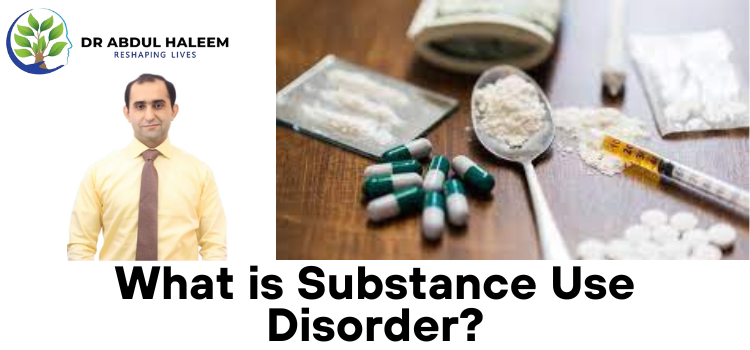
All people must know what is substance use disorder. Substance Use Disorder (SUD) is a complex and chronic brain disease that affects millions of people worldwide. It is characterized by the compulsive use of substances despite harmful consequences, leading to addiction and dependence.
In this blog post, we will discuss the definition, symptoms, causes, and treatment options for SUD. It is important to note that SUD can affect anyone, regardless of age, gender, race, or socioeconomic status.
Read more to get further details.
What is Substance Use Disorder?
Substance use disorder (SUD) is a term used to describe a range of conditions related to the compulsive and harmful use of substances. It includes both substance abuse and addiction, which are often used interchangeably but have distinct meanings.
Substance abuse refers to the misuse or overuse of drugs or alcohol, while addiction is characterized by physical and psychological dependence on a substance. Both substance abuse and addiction are considered forms of SUD.
Symptoms
The symptoms of SUD vary depending on the individual and the type of substance being abused. However, some common signs and indicators can help identify if someone is struggling with SUD.
Physical Symptoms
Some physical symptoms may include:
- Changes in weight or appetite
- Bloodshot eyes
- Frequent nosebleeds (for those who snort drugs)
- Slurred speech
- Tremors, seizures, or convulsions
Behavioral Symptoms
Some behavioral symptoms may include:
- Changes in mood or behavior
- Neglecting responsibilities and obligations
- Isolating from friends and family
- Engaging in risky or dangerous behaviors
- Lying or stealing to obtain drugs
Psychological Symptoms
Some psychological symptoms may include:
- Intense cravings for the substance
- Difficulty controlling use of the substance
- Withdrawal symptoms when not using the substance
- Continued use despite negative consequences
Causes
There is no single cause of SUD, but rather a combination of biological, environmental, and psychological factors can contribute to the development of this disorder.
Biological Factors
Some biological factors that may increase the risk of developing SUD include:
- Genetics: Some individuals may be more susceptible to addiction due to genetic predisposition.
- Brain Chemistry: Imbalances in neurotransmitters can affect an individual’s response to substances.
Environmental Factors
Some environmental factors that may contribute to the development of SUD include:
- Exposure to trauma or stress
- Peer pressure and influence
- Availability and accessibility of substances
Psychological Factors
Some psychological factors that may play a role in SUD include:
- Mental health disorders, such as depression or anxiety
- Coping with trauma or unresolved emotional issues
- Low self-esteem or lack of purpose in life
Effects
Untreated SUD can have devastating effects on an individual’s physical, mental, and social well-being. Some possible consequences of SUD may include:
- Damaged relationships with loved ones
- Financial problems and debt
- Increased risk of accidents or injuries
- Decline in work or academic performance
- Legal issues related to substance use
What are the Stages of Drug Use?
The stages of drug use refer to the different phases an individual may go through as they develop SUD. These stages are not always linear and can vary depending on the substance being used, but they generally follow a pattern of experimentation, regular use, abuse, and dependence.
Experimentation
This stage typically involves trying a substance for the first time out of curiosity or peer pressure.
Regular Use
In this stage, an individual begins to use the substance regularly, often in social settings or to cope with stress or emotions.
Abuse
At this stage, an individual’s substance use has become problematic and is causing negative consequences. They may begin to neglect responsibilities and obligations and experience physical, psychological, and social problems.
Dependence
The final stage is characterized by physical and psychological dependence on the substance. An individual may experience intense cravings, and withdrawal symptoms when not using, and have difficulty controlling their use of the substance.
Treatment Options
SUD is a treatable disorder, and there are various treatment options available depending on the individual’s needs. Some common treatment approaches include:
Detoxification
Detoxification is typically the first step in treating SUD, and it involves removing all traces of the substance from the body. This may be done in a medical setting, under the supervision of healthcare professionals.
Therapy
Various types of therapy can help individuals with SUD address underlying issues and develop healthy coping mechanisms. Examples include cognitive-behavioral therapy, group therapy, and family therapy.
Medications
Some medications can help reduce cravings and manage withdrawal symptoms during the recovery process. These may be prescribed by a healthcare professional in combination with therapy.
Support Groups
Support groups offer a supportive and non-judgmental environment for individuals struggling with SUD to connect with others who share similar experiences.
Conclusion
People should be aware about what is substance abuse disorder and its causes and effects. Substance use disorder is a complex and challenging condition, but it is important to know that recovery is possible. Seeking help and support from healthcare professionals, loved ones, and support groups can greatly improve the chances of successful treatment and long-term sobriety.
Remember, SUD does not discriminate, but neither does recovery. With proper treatment and support, individuals with SUD can lead fulfilling and healthy lives.
FAQs
Some of the frequently asked questions by people are:
What are the 4 categories of substance use disorder?
The 4 categories of substance use disorder are Stimulants, Depressants, Hallucinogens and Opioids.
What are the causes of addiction?
There is no single cause of addiction, but factors such as genetics, brain chemistry, environmental influences, and psychological factors can contribute to its development.
What are the five factors of substance abuse?
The five factors of substance abuse are genetics, brain chemistry, exposure to trauma or stress, peer pressure and influence, and mental health disorders.
What is the most common substance related disorder?
The most common substance related disorder is alcohol use disorder, followed by tobacco use disorder and cannabis use disorder.


